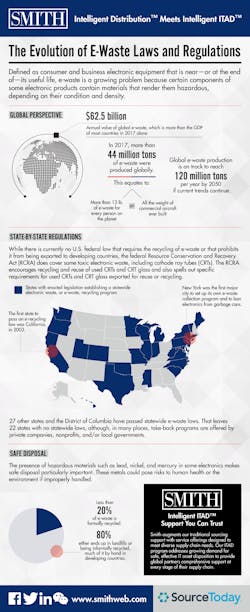According to a recent PACE/UN report, global e-waste production is on track to reach 120 million tons per year by 2050 if current trends continue. The annual value of global e-waste is now at over $62.5 billion, more than the gross domestic product (GDP) of most countries.
In 2017 alone, more than 44 million tons of electronic and electrical waste were produced globally, which equates to more than 13 lb. for every person on the planet. “This is equivalent in weight to all the commercial aircraft ever built,” PACE points out in its report.
Defined as consumer and business electronic equipment that is near—or at the end of—its useful life, e-waste is a growing problem because certain components of some electronic products contain materials that render them hazardous, depending on their condition and density.
The Hazards of E-Waste
Tasked with procuring the electronic components and other products that companies rely on to make their own products, buyers can play a role in helping to chip away at some of those rising numbers. By following the state and federal laws that are being set forth, and by working with suppliers that also adhere to those regulations, buyers can do their part in cutting down on and/or eliminating the volume of e-waste that occupy the nation’s landfills.
“Although used electronics make up a relatively small percentage of the overall waste stream, their disposal is a source of concern for several reasons,” the National Conference of State Legislatures (NCSL) points out. For example, electronic device production requires a significant amount of resources—metals, plastics, and glass—many of which can be recovered through recycling.
For example, the production of one desktop computer takes at least 530 lb. of fossil fuels, 48 lb. of chemicals, and 1.5 tons of water. Cell phones are also resource-intensive, being composed of precious metals such as silver, gold, palladium, and copper. “Recovering these and other materials through recycling uses a fraction of the energy needed to mine new metals,” NCSL notes.
In addition, the presence of hazardous materials such as lead, nickel, and mercury in some electronics make safe disposal particularly important. These metals could pose risks to human health or the environment if improperly handled.
State-by-State Regulations
The first state to pass an e-recycling law was California, in 2003. Since then, 27 other states and the District of Columbia have followed suit. That leaves 22 states with no statewide laws, although, in many places, take-back programs are offered by private companies, nonprofits, and/or local governments (New York was the first major city to set up its own e-waste collection program and to ban electronics from garbage cans).
According to the Environmental Protection Agency (EPA), here are a few examples that buyers should be aware of (the full list is published online here):
Indiana. Requires manufacturers of video display devices to collect and recycle 60% by weight of the volume of products they sold in the previous year in Indiana. After the first two years, manufacturers that fail to meet those goals will pay an additional recycling fee for every pound they fall short of their goal. (Covered devices include TVs, computers, laptops, keyboards, printers, fax machines, DVD players, and video cassette recorders.)
Minnesota. Manufacturers of covered devices must register with the state, pay a registration fee, and set up an e-waste recycling program. These manufacturers must also meet specified recycling goals, including 60% of the weight of covered electronic devices sold in the state by July 2008 and 80% each year thereafter.
Missouri. Manufacturers of computers must implement “recovery plans” for the collection of and the recycling or reuse of their obsolete equipment. The recovery plan must be implemented and a copy of the plan submitted to the Department of Natural Resources before the manufacturer can sell its computers in Missouri.
Oklahoma. Requires computer manufacturers to provide the Department of Environmental Quality proof of a computer recovery or recycling program, such as a mail-back system, collection events, or contracts with state electronic recycling shops. It also disqualifies any manufacturer from participating in bids for state contracts if they are not in compliance.
Oregon. Manufacturers of covered electronic devices must register to participate in recycling programs and provide collection sites for e-waste. Manufacturers pay a fee dependent on their market share of CEDs sold in the state. The law also prohibits a collection fee for CEDs.
While there is currently no U.S. federal law that requires the recycling of e-waste or that prohibits it from being exported to developing countries, the federal Resource Conservation and Recovery Act (RCRA) does cover some toxic electronic waste, including cathode ray tubes (CRTs). The RCRA encourages recycling and reuse of used CRTs and CRT glass and also spells out specific requirements for used CRTs and CRT glass exported for reuse or recycling.











